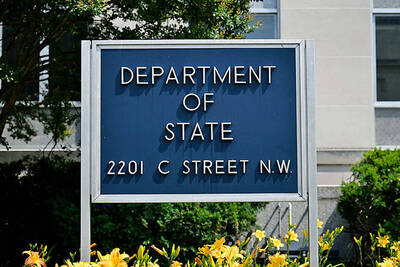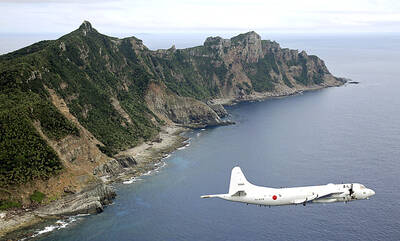Japan’s latest defense white paper highlights Taiwan’s defense measures, as well as Tokyo’s and the international community’s concerns over stability in the Taiwan Strait.
Japanese Prime Minister Fumio Kishida’s Cabinet yesterday approved the 500-page report — the second published under Japanese Minister of Defense Nobuo Kishi that gives substantial attention to the Taiwan issue.
Last year’s edition for the first time separated Taiwan from a chapter devoted to China and placed it in a section on China-US relations.

Photo: CNA
This year’s edition includes 10 pages on Taiwan, double the length of last year’s paper.
The paper introduces Taiwan’s defense situation and its approach to national defense, as well as the international situation Taipei is operating under, with a focus on Taiwan’s guidelines of “solid defense, layered deterrence” and asymmetric warfare.
The paper also mentions Taiwanese measures to mitigate the effects of Chinese cognitive warfare, including using a combined form of electronic and cyberwarfare capabilities to create “beachheads.”
The military balance continues to be tipped in China’s favor, but against a backdrop of the Russia-Ukraine war, Taiwan’s efforts to strengthen its defensive capabilities should be noted, it says.
The US, without deviating from its “one China” policy, has since the administration of former US president Donald Trump stepped up efforts to deepen US-Taiwan relations, a trend that has continued under US President Joe Biden. His administration defines Taiwan as a principal democratic, economic and security partner, and sends US ships through the Taiwan Strait while continuing sales of arms packages to Taiwan, the paper says.
In addition to the US, the international community — led by Europe — has also voiced concern over stability in the Taiwan Strait and has been reinforcing EU-Taiwan relations, it says.
“Taiwan is an extremely important partner for Japan,” it says. “The stability of the situation surrounding Taiwan is also critical for Japan’s security and must be closely monitored with a sense of urgency ... based on the recognition that changes to the status quo by coercion are globally shared challenges.”
Ministry of Foreign Affairs spokeswoman Joanne Ou (歐江安) said that Taiwan welcomes the international community’s concerns and measures, which contribute positively toward maintaining regional peace and stability.
The ministry anticipates the possibility of working with like-minded countries, including Japan, to jointly defend democracy and uphold stability in the Taiwan Strait and the Indo-Pacific region, Ou said.
In a new chapter devoted to Russia’s war in Ukraine, the report said that Russia’s international isolation and fatigue from the war might increase the importance of Moscow’s political and military cooperation with China.
Military cooperation between the two countries should be closely watched, because it could have a “direct impact” on Japan’s security, the paper says.
The report comes as Kishida’s government pledges to bolster Japan’s military capability and budget under a revised national security strategy and basic defense guidelines that are planned for release later this year.
China yesterday said it firmly opposed the white paper and had sent stern representations to Tokyo.
“Japan’s new defense white paper makes accusations and smears China’s defense policy, market economic development and legitimate maritime activities,” Chinese Ministry of Foreign Affairs spokesman Wang Wenbin (汪文斌) told a daily news briefing.
The report “exaggerates the so-called China threat” and interferes in China’s internal affairs on Taiwan, Wang said.
Additional reporting by AP and Reuters

MISINFORMATION: The generated content tends to adopt China’s official stance, such as ‘Taiwan is currently governed by the Chinese central government,’ the NSB said Five China-developed artificial intelligence (AI) language models exhibit cybersecurity risks and content biases, an inspection conducted by the National Security Bureau (NSB) showed. The five AI tools are: DeepSeek, Doubao (豆包), Yiyan (文心一言), Tongyi (通義千問) and Yuanbao (騰訊元寶), the bureau said, advising people to remain vigilant to protect personal data privacy and corporate business secrets. The NSB said it, in accordance with the National Intelligence Services Act (國家情報工作法), has reviewed international cybersecurity reports and intelligence, and coordinated with the Ministry of Justice Investigation Bureau and the National Police Agency’s Criminal Investigation Bureau to conduct an inspection of China-made AI language

BOOST IN CONFIDENCE: The sale sends a clear message of support for Taiwan and dispels rumors that US President Donald Trump ‘sold out’ the nation, an expert said The US government on Thursday announced a possible sale to Taiwan of fighter jet parts, which was estimated to cost about US$330 million, in a move that an expert said “sends a clear message of support for Taiwan” amid fears that Washington might be wavering in its attitude toward Taipei. It was the first announcement of an arms sale to Taiwan since US President Donald Trump returned to the White House earlier this year. The proposed package includes non-standard components, spare and repair parts, consumables and accessories, as well repair and return support for the F-16, C-130 and Indigenous Defense Fighter aircraft,

CHECKING BOUNDARIES: China wants to disrupt solidarity among democracies and test their red lines, but it is instead pushing nations to become more united, an expert said The US Department of State on Friday expressed deep concern over a Chinese public security agency’s investigation into Legislator Puma Shen (沈伯洋) for “secession.” “China’s actions threaten free speech and erode norms that have underpinned the cross-strait ‘status quo’ for decades,” a US Department of State spokesperson said. The Chongqing Municipal Public Security Bureau late last month listed Shen as “wanted” and launched an investigation into alleged “secession-related” criminal activities, including his founding of the Kuma Academy, a civil defense organization that prepares people for an invasion by China. The spokesperson said that the US was “deeply concerned” about the bureau investigating Shen

DISPUTE: A Chinese official prompted a formal protest from Tokyo by saying that ‘the dirty head that sticks itself out must be cut off,’ after Takaichi’s Taiwan remarks Four armed China Coast Guard vessels yesterday morning sailed through disputed waters controlled by Japan, amid a diplomatic spat following Japanese Prime Minister Sanae Takaichi’s comments on Taiwan. The four ships sailed around the Senkaku Islands — known as the Diaoyutai Islands (釣魚台) to Taiwan, and which Taiwan and China also claim — on Saturday before entering Japanese waters yesterday and left, the Japan Coast Guard said. The China Coast Guard said in a statement that it carried out a “rights enforcement patrol” through the waters and that it was a lawful operation. As of the end of last month,